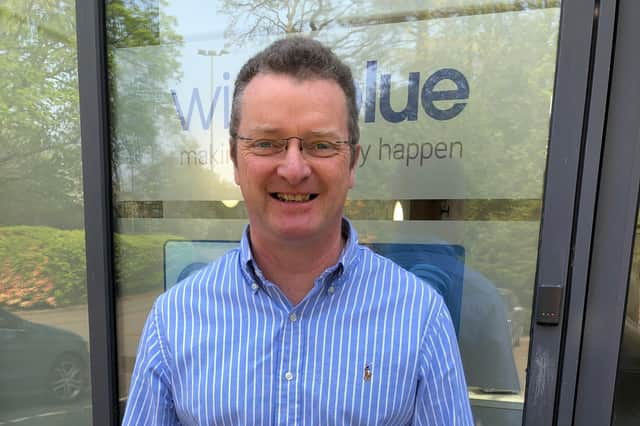How we pivoted production to tackle Covid-19 - comment


Like with all businesses, and life in general, Covid-19 has changed the medical device sector. In general, we are seeing many of our customers switch development of existing products towards solutions to combat Covid or adapt to the new “normal”. The Corona pandemic has opened up a new strand of business for us that has more than offset reduced activity in other product design areas.
Almost daily, we have customers approaching us with new medical device enquiries mainly related to Covid. This includes adapting rapid diagnostic tests for use with Covid patients as well projects relating to surface cleanliness and patient isolation.
Advertisement
Hide AdAdvertisement
Hide AdIn particular, we have recently accelerated production of a groundbreaking new medical device that could help the NHS quickly discover which Covid-19 patients are deteriorating and need a ventilator.
The device, N-Tidal, developed for our client Cambridge Respiratory Innovations (CRI), is a simple-to-use, fully automated, small battery-powered personal capnometer, which is used to measure the amount of carbon dioxide (CO2) in exhaled breath during normal relaxed breathing.
The changes in CO2 concentration as a patient breathes in and out through the device are measured and can be used to assess the health of a patient’s lungs and general condition.
Amid a shortage of ventilators, the device could enable clinicians to prioritise their use based on firm data. The device may also be useful to track progress of patients as they recover after ventilator use.
Normally, a device called a spirometer is used to assess lung function, but this requires the patient to blow long and hard into a tube; Covid-19 patients do not have the energy to do this.
Furthermore, blowing hard into the spirometer can disperse coronavirus particles and create an aerosol of the virus in the air. The N-Tidal device can be used to assess patients’ lungs without generating dangerous aerosols. Trials have been ongoing in NHS and US hospitals over the past couple of months.
Reconfigured
We have made 200 devices already, with a further 1,000 units in the pipeline. These devices were destined for clinical trials with chronic obstructive pulmonary disease and asthma patients, but these devices are now being reconfigured and reallocated to Covid-19 patients.
We would also normally carry out a technology transfer to a volume manufacturer, but, given the immediate need and the inability to travel to support start-up production at an external manufacturing company, we are scaling up production in house.
Advertisement
Hide AdAdvertisement
Hide AdOver the next few weeks, we will purchase additional materials, reconfigure our product-development labs to become production areas, train additional staff and assemble new N-Tidal devices, Breath tubes and mouthpieces. It is quite an exciting time in the development of this new product and one we are proud to be manufacturing and doing our bit in the fight against coronavirus.
Designing new products for the medical device sector is extremely challenging and complex, as this industry is – quite rightly – heavily regulated, as new products are often used in life-or-death situations. Many of the features incorporated into the N-Tidal reflect current trends in medical device development.
In general, new medical devices are becoming ever smaller and battery powered, meaning that more energy-efficient electronics have to be packed into smaller spaces, leading to greater miniaturisation of electronic components. Most new devices also have wireless or bluetooth capability built in, where data is being transmitted to a nearby device, server or remote site.
Data security, encryption and patient confidentiality is a key consideration, as patient data can be transmitted across multiple nodes. In terms of wireless network choice, there is a trade-off between speed, reliability and longevity – 5G might be fast but 2G could be more reliable and more readily available in some parts of the world.
At Wideblue, we are proud to be carrying on Scotland’s rich history of innovation and enterprise in this sector. Currently, we have a team of 20 scientists and turn over approximately £2 million. Customers range from multinationals, to start-ups, university spin-outs and research and development collaborations from across the globe.
Outwith the medical device sector, both Wideblue and our sister company have some customers cutting back and preserving cash. However, many others are accelerating new product introduction to gain early market advantage for their new technologies. Examples include remote monitoring applications, renewable energy and electric vehicle technology.
A message from the Editor:
Thank you for reading this story on our website. While I have your attention, I also have an important request to make of you.
The dramatic events of 2020 are having a major impact on many of our advertisers - and consequently the revenue we receive. We are now more reliant than ever on you taking out a digital subscription to support our journalism.
Advertisement
Hide AdAdvertisement
Hide AdSubscribe to scotsman.com and enjoy unlimited access to Scottish news and information online and on our app. Visit https://www.scotsman.com/subscriptions now to sign up. By supporting us, we are able to support you in providing trusted, fact-checked content for this website.
Joy Yates
Editorial Director
Comments
Want to join the conversation? Please or to comment on this article.